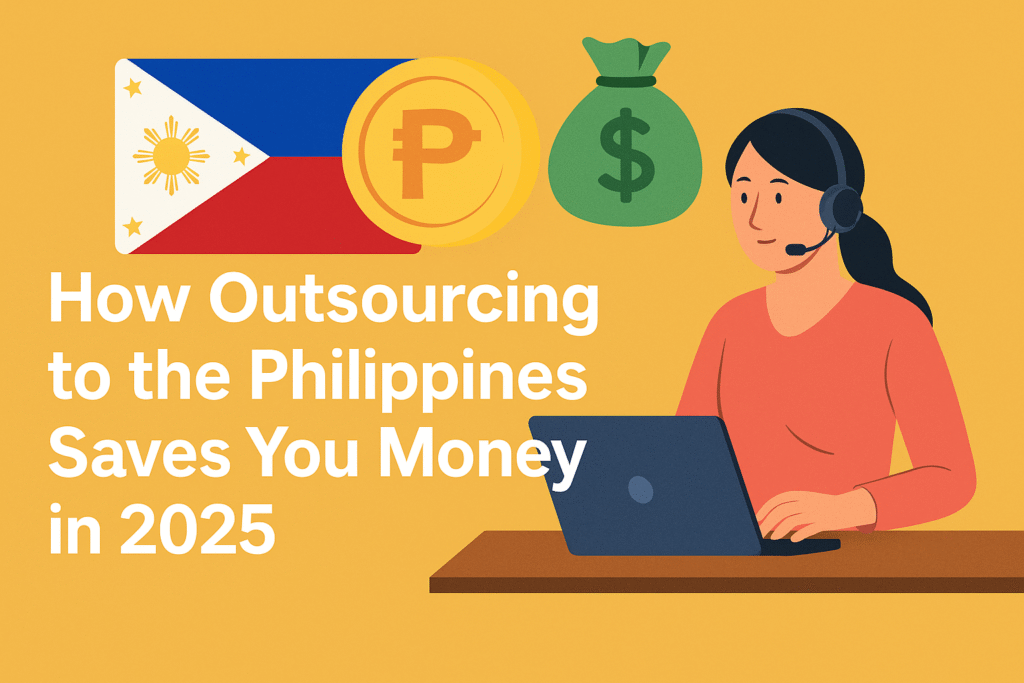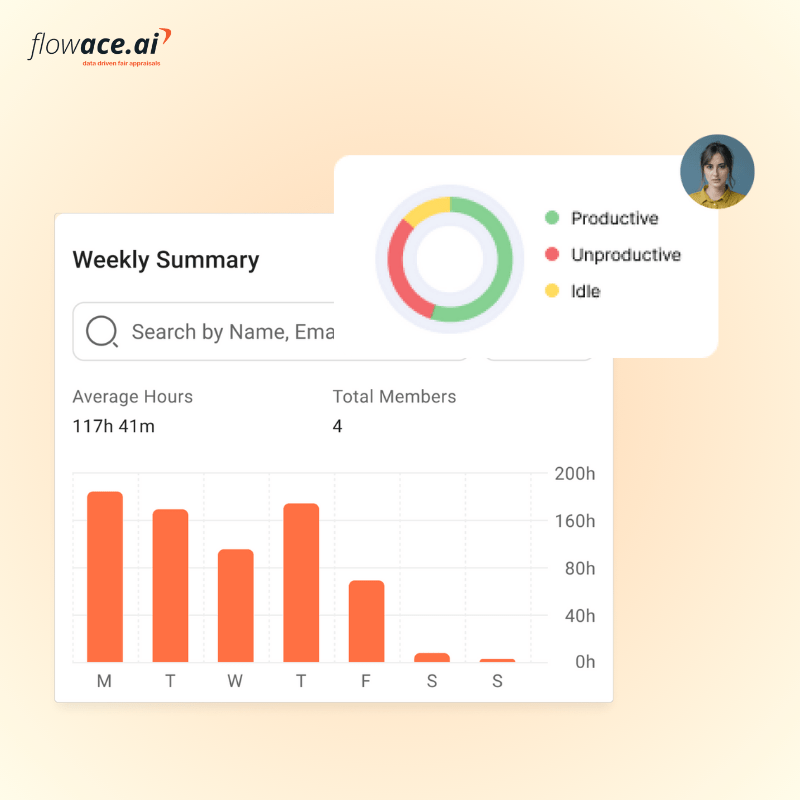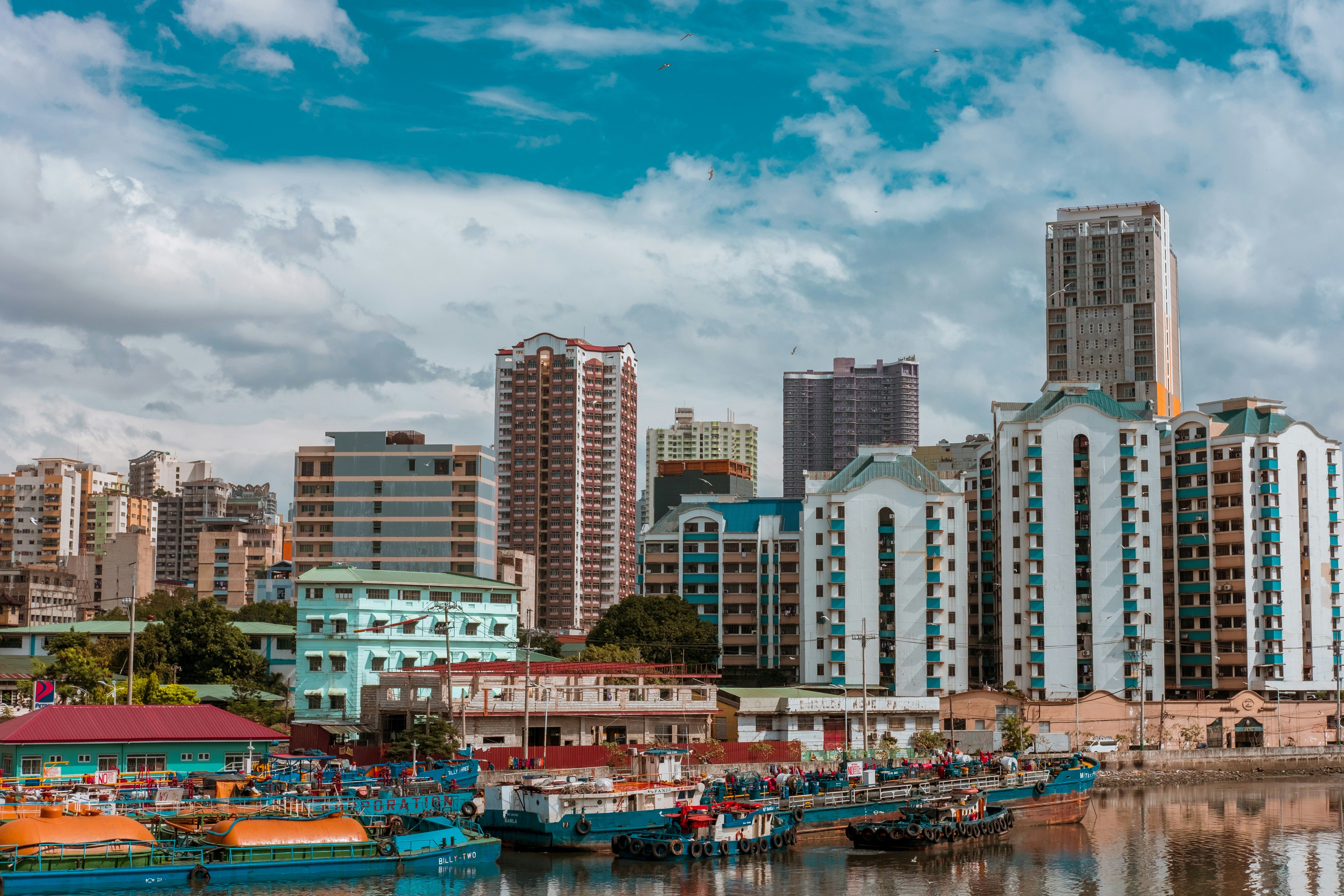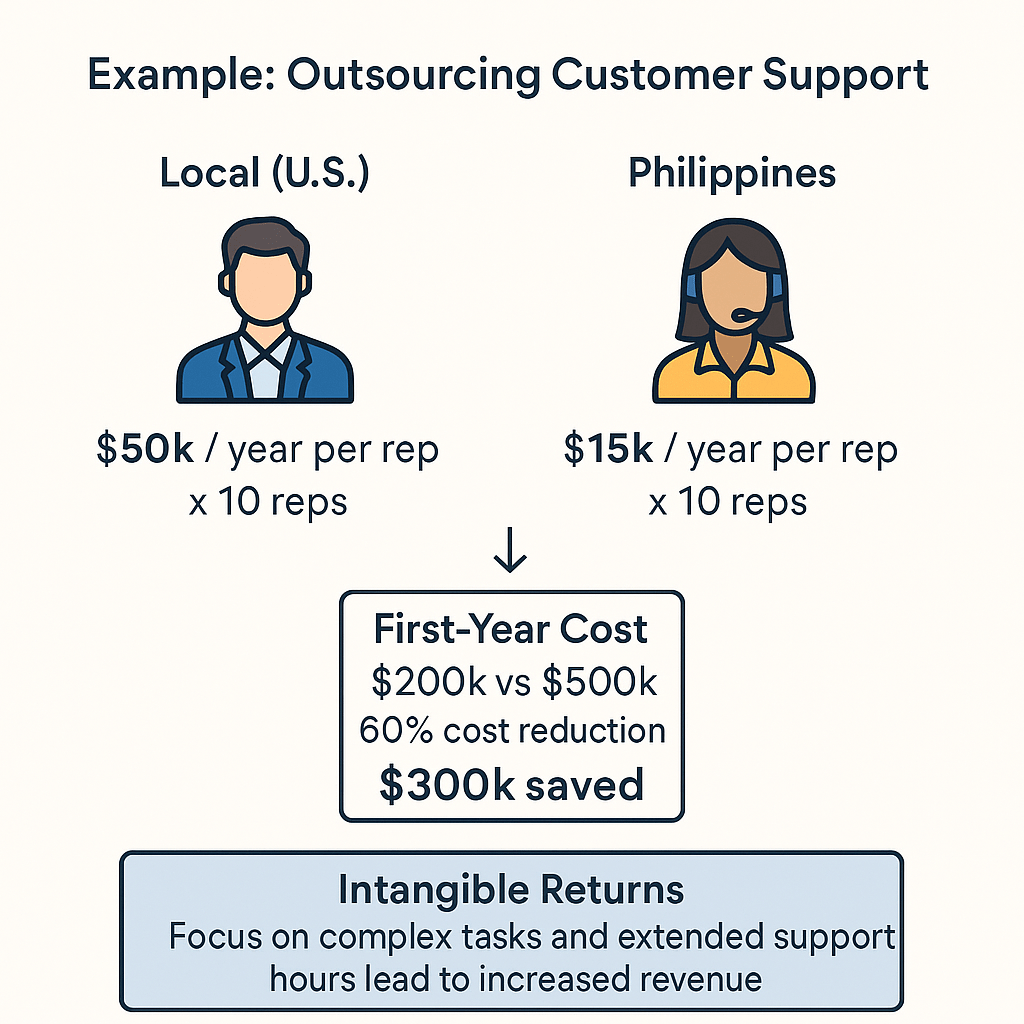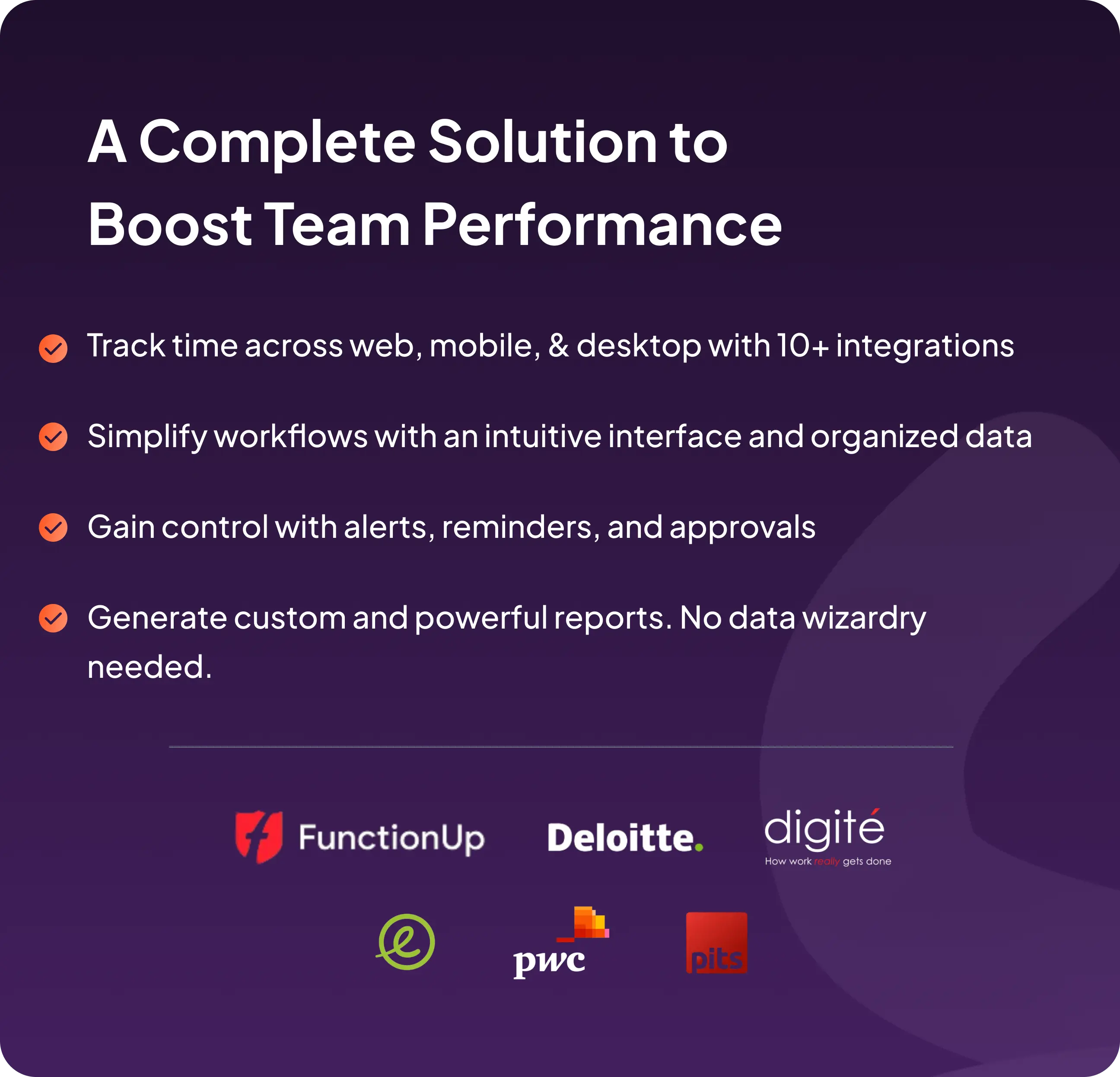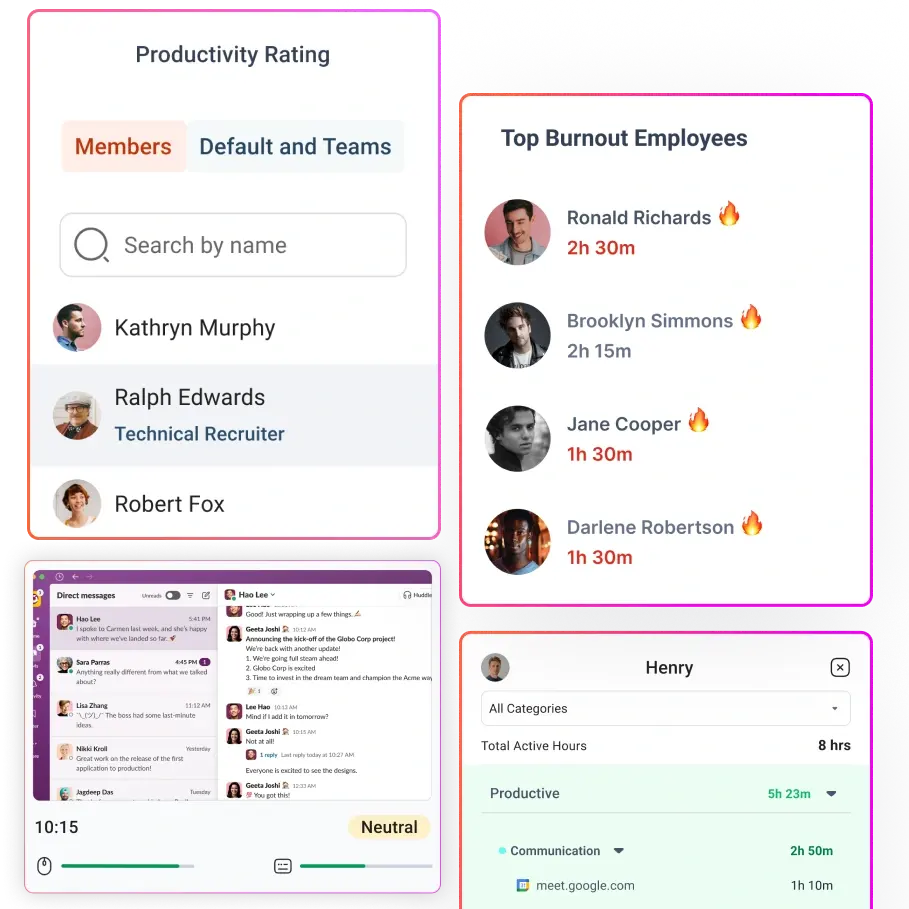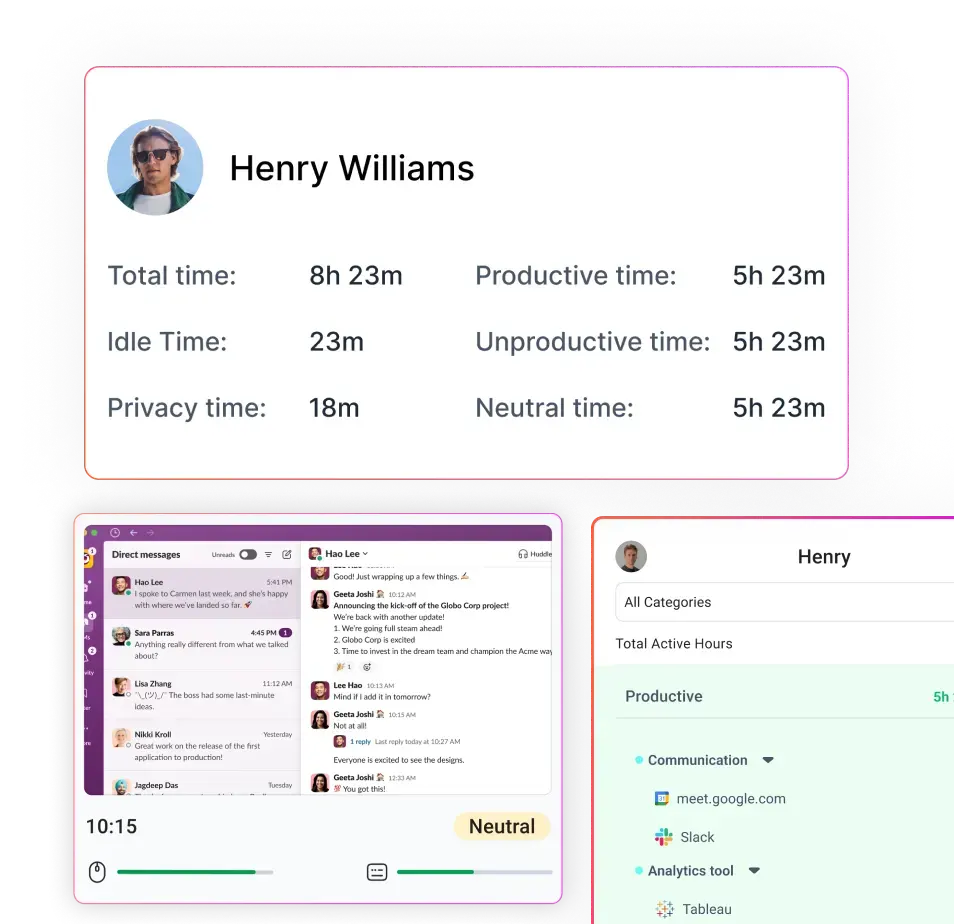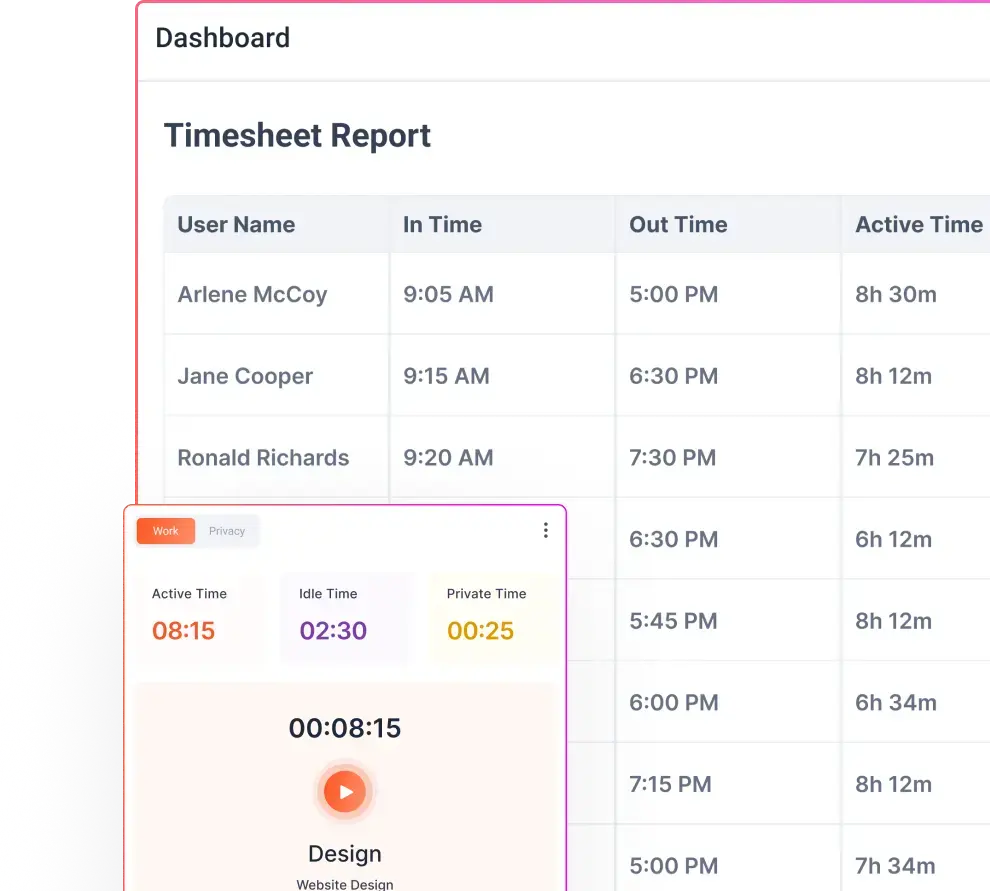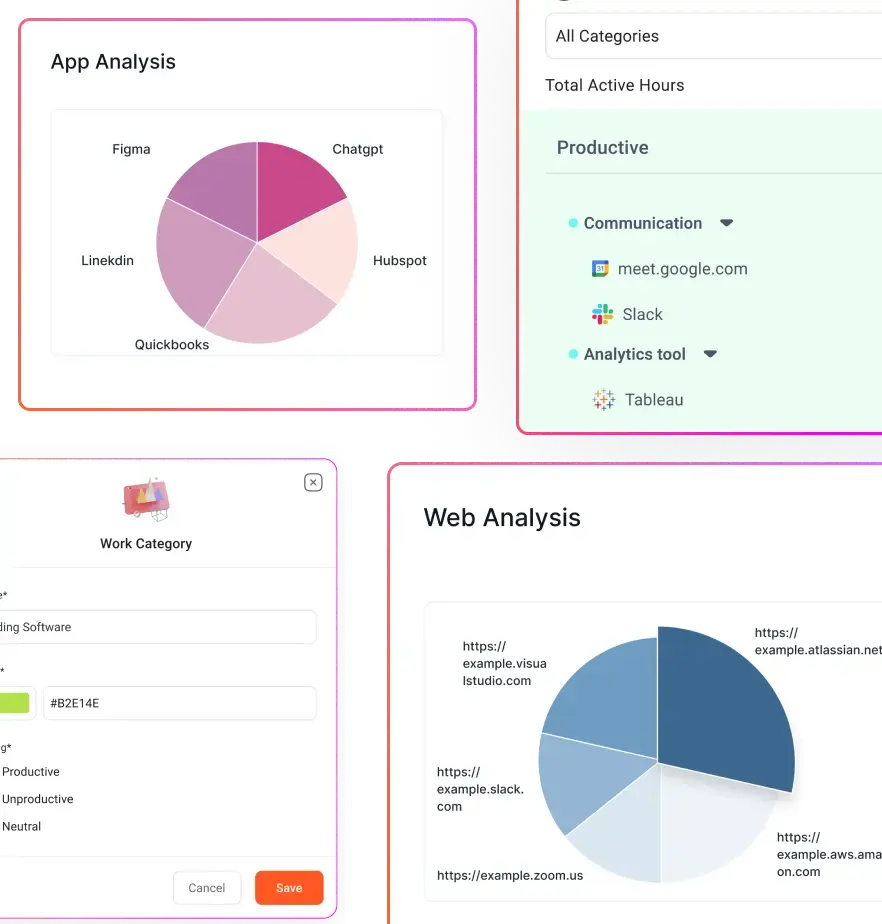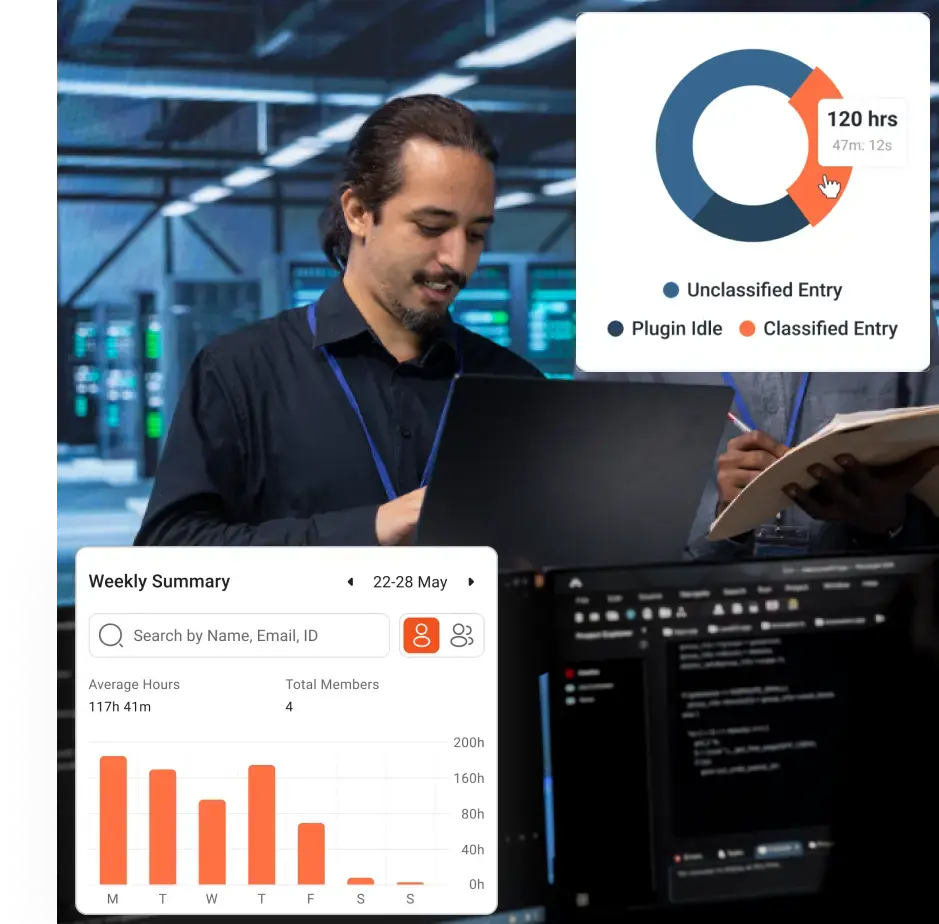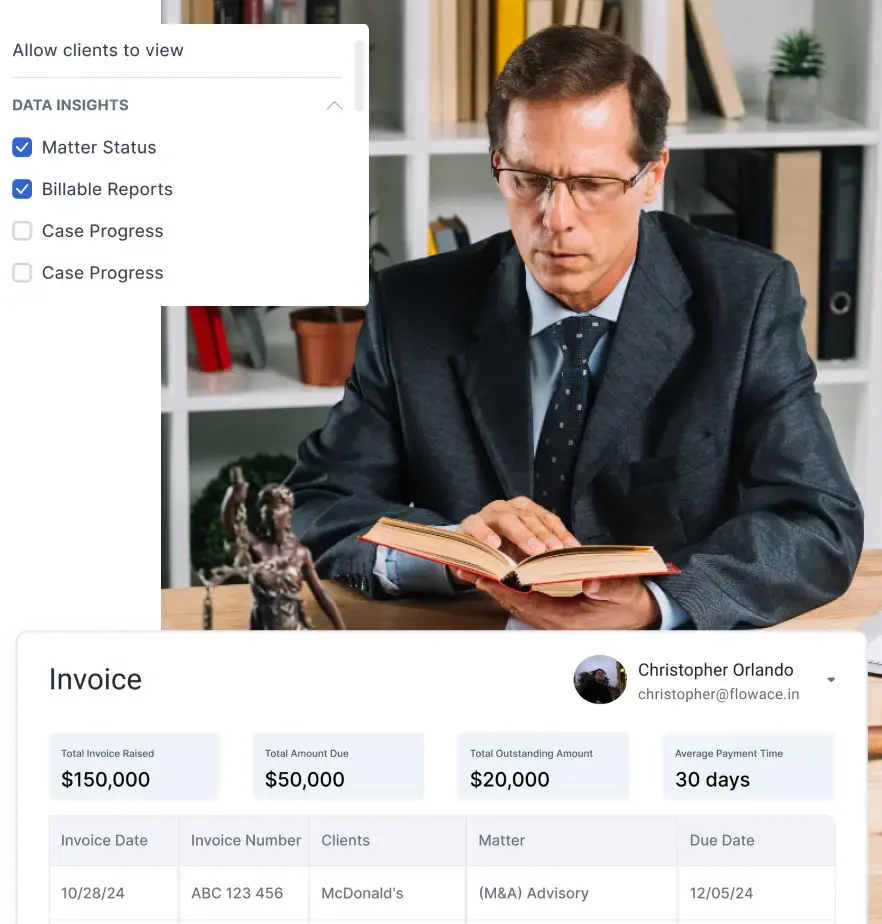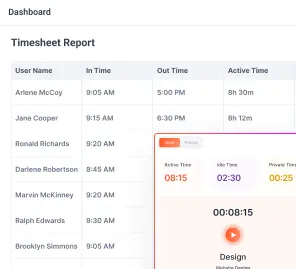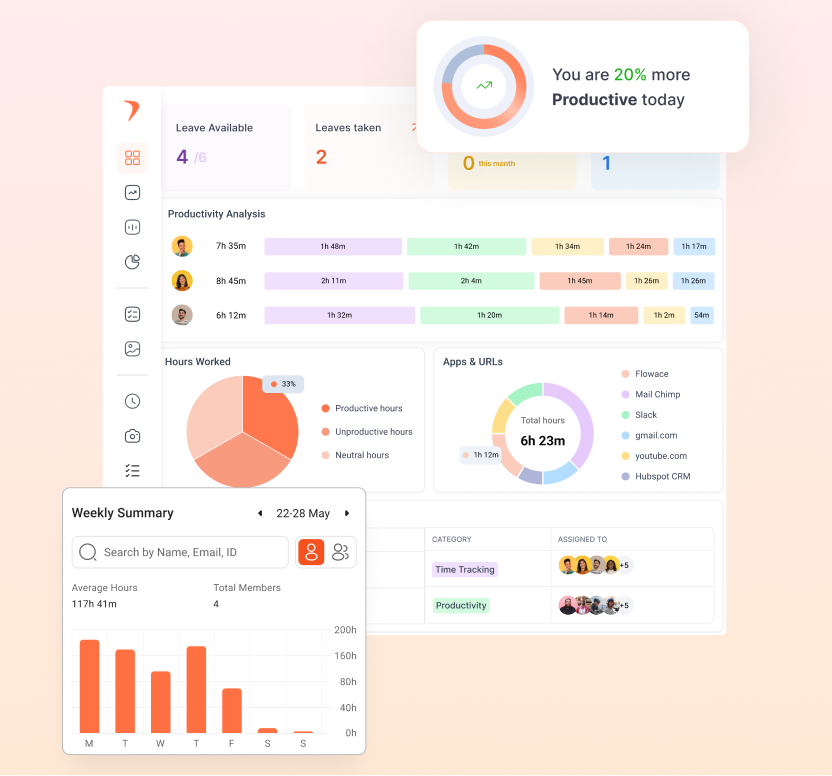In 2024, the Philippine IT‑BPM (BPO) sector reached $38 billion in revenues, up 7% from $35.5 billion in 2023, and contributed roughly 8–9% of GDP. However, rising local wages, increased competition from India and nearshoring, and the advent of AI/automation are reshaping the landscape.
In this article, we are trying to answer the big question: Is outsourcing to the Philippines worth it in 2025?
Key Takeaways:
- Outsourcing to the Philippines can cut labor and operational costs by up to 70%, making it one of the most cost-effective global outsourcing destinations in 2025.
- The Philippines boasts a skilled, English-proficient workforce with strong cultural alignment to the West, ideal for roles in customer support, IT, design, and more.
- 24/7 operations and faster project turnarounds make Philippine outsourcing perfect for businesses needing global coverage, overnight progress, or “follow the sun” workflows.
- Despite rising local wages and hidden setup costs, the ROI remains strong (often 2x to 3x) when managed with the right tools and expectations.
- Flowace helps maximize outsourcing ROI by solving key challenges like time zone gaps, work visibility, and productivity tracking, ensuring every dollar paid results in meaningful output. Book your free trial now and watch your team deliver more, even while you sleep.
What Makes the Philippines a Global Outsourcing Hub?
A combination of economic, talent, and policy factors has turned the Philippines into a global outsourcing hub. Here’s why the country stands out:
Booming BPO Industry with Strong Growth
When you outsource to the Philippines, you’re stepping into a booming $38 billion industry. It’s growing at around 7% every year. That’s way faster than the global outsourcing average.
BPO now fuels 11% – 15% of the country’s entire economy. It’s a big reason why the Philippines is growing so quickly.
With that kind of momentum, it’s no surprise the country has become one of the top outsourcing hotspots in the world.
#1 in Call Centers and Voice Support
The Philippines is often called the “Call Center Capital of the World.” It handles about 13% of the global BPO market and leads in voice-based services like customer support and sales. Top call centers often combine Philippine talent with a Pitman schedule to guarantee 24/7 customer care without fatigue.
With over 700 BPO firms and global giants like Accenture and Google already operating there, you’ll have plenty of reliable partners to choose from.
Young, Skilled, and Ready Talent
A key strength of the Philippines is its human capital. The workforce is young, tech-savvy, and well-educated, with a 97% literacy rate.
Today, an estimated 1 to 1.8 million Filipinos are employed in the IT-BPO sector, indicating the depth of available talent. This talent pool includes software engineers, financial analysts, graphic designers, and virtual assistants. Companies can find skilled professionals for nearly any role, not just call centers.
For example, Slack leveraged Filipino designers to help create its user interface, a partnership that contributed to Slack’s product success.
High English Proficiency & Cultural Fit
Language and culture are often make-or-break factors in outsourcing. The Philippines shines here with exceptional English fluency and Western cultural affinity.
English is one of the official languages and the primary medium of instruction in schools. According to the EF English Proficiency Index, the Philippines is rated “High Proficiency” in English and ranks 2nd in Asia.
Most Filipinos grow up consuming American media. This results in a workforce that speaks American-accented English, understands Western idioms, and can communicate with U.S. or European customers seamlessly.
Pro-Outsourcing Government Support
The Philippine government invests in upskilling the digital workforce. For example, Republic Act No. 11927 (2023) mandates a council to create training programs (with IT-BPO companies) in skills like virtual assistance, graphic design, animation, and SEO.
This helps ensure the Filipino talent stays competitive for emerging outsourcing needs (like AI, data analytics, etc.). The industry body IBPAP (IT & Business Process Association of the Philippines) also collaborates with the government on industry roadmaps, aiming to make the Philippines the “top digital experience hub” globally by 2028.
Why Do Businesses Outsource to the Philippines?
Let’s break down the key reasons companies choose the Philippines for outsourcing, from cost savings to talent quality:
Cost Efficiency
- Labor Cost Difference
-
-
- Outsourcing to the Philippines costs 50% less than the U.S. for similar roles. Hourly rates average $12–$14 vs. $24–$28 in the U.S.
- Even for experienced agents, salaries are much lower, around $500–$600/month, compared to $5,000+ in the U.S.
- According to KDCI, outsourcing can cut overhead costs by 70% to 90% when you factor in wages, benefits, and infrastructure.
-
- Total Operational Savings
-
-
- A U.S. company may spend $50K–$70K per employee yearly, but outsourcing to the Philippines can slash that in half.
- Studies show you can realistically save around 50% overall. Small businesses with under 100 staff can save up to $65K a year by outsourcing back-office tasks.
-
- Flexible Pricing Models
-
- The market is competitive, so you get pricing that fits your budget. Choose from hourly rates, fixed monthly fees, or output-based plans.
- Many vendors offer volume discounts and scalable options, so costs go down as your team grows.
Achieve 24/7 Coverage and Faster Turnarounds
- Round-the-Clock Customer Support
-
-
- Philippine BPOs run 24/7, letting you offer support while your U.S. team sleeps.
- With 76% of service teams offering after-hours support, Filipino agents help meet modern customer expectations.
-
- Faster Project Turnarounds
-
-
- With teams in opposite time zones, you get overnight progress. U.S. managers can assign work at night and wake up to completed tasks.
- Philippine teams also align with Asia-Pacific hours, making them ideal for multi-region businesses.
-
- “Follow the Sun” Operations
-
- Philippine IT teams handle overnight monitoring and issue resolution.
- Creative teams prep content overnight, enabling continuous productivity with minimal hand-off overlap.
Skilled, High-Quality Talent Readily Available
- Skilled and Specialized Talent
-
-
- The Philippines produces hundreds of thousands of grads yearly in IT, finance, healthcare, and design.
- Many BPOs specialize by domain, so hiring trained experts is fast and easy.
-
- English-Proficient and Customer-Focused
-
-
- Filipinos speak fluent English with neutral accents and provide warm, respectful service.
- They’re also trained in business tools like CRMs and project software for quick onboarding.
-
- Strong Work Ethic & Performance Culture
-
-
- Filipino teams are known for dedication, adaptability, and a drive to improve.
- Many have low turnover thanks to benefits like healthcare and 13th-month pay. This results in stable, high-performing teams that rival costlier onshore ones.
-
- Specialized Skills & Innovation
-
- You’ll find experts in AI, cloud, design, and healthcare. This helps fill the global tech talent gap, with Phillipino professionals certified in AWS, accounting, and more.
Services or Industries the Philippines are Best At
- Customer Support & Contact Centers:
-
-
- A global leader in voice, chat, email, and social support.
- Philippine call centers hit top KPIs and hold a major share of the $150B global call center market.
- Trusted by telecom, banking, and e-commerce sectors.
-
- Back-Office & Admin Services:
-
-
- Experts in data entry, payroll, HR, finance, and transcription.
- Certified accountants handle global bookkeeping.
- Government-backed upskilling (RA 11927) supports virtual assistant and SEO roles.
-
- IT & Software Development:
-
-
- Filipino devs excel in web/mobile dev, QA, and tech support, with strong English communication.
- Cities like Manila and Cebu host thriving tech hubs, also known for game dev and animation.
-
- Creative & Content Services:
-
-
- Outsource design, video editing, copywriting, and digital marketing.
- Filipino creatives produce global-standard content, trusted by firms like Canva and Shutterstock.
-
- Healthcare & Other Niches:
-
- Leading in medical billing, coding, and telehealth, thanks to a large nursing talent pool.
- Also skilled in legal outsourcing, engineering, and analytics.
ROI Breakdown: What Return on Investment Can Outsourcing to the Philippines Deliver?
Dramatic Labor Cost Savings
Labor cost differences drive high ROI in outsourcing. Hiring a Filipino engineer for $20K/year vs. an American for $100K saves you $80K. Scale that across 10 or 100 roles, and the savings grow fast. According to Outsource Accelerator, outsourcing can deliver ROI up to 231% in some functions, far above the ~60% seen in-house. Even with provider fees, total costs remain 50–70% lower. That means a U.S. team costing $1M could be replaced with a Philippine team for $300K, saving $700K you can reinvest.
Maintaining Quality and Productivity
The Philippines delivers solid quality, especially in customer service and back-office tasks. Many teams meet or exceed U.S. benchmarks thanks to strong English skills and good training. Productivity per dollar is often higher, and some firms report 25% performance gains. Outsourcing vendors usually have fine-tuned processes, which help improve speed, accuracy, and 24/7 support. This leads to better metrics across the board, like customer satisfaction and sales.
Scalability and Flexibility
Outsourcing turns fixed costs into variable ones. Need to grow fast? Add headcount without leasing new offices or buying equipment. Outsourcing providers take care of that. If demand drops, scale back more easily than laying off full-time staff. This “pay-as-you-go” model helps protect your cash flow. You invest less upfront and only pay for what you use—improving your return on capital and keeping operations nimble.
Hidden Cost Considerations
Hidden costs can reduce net ROI if not managed. Think onboarding, vendor training, and travel expenses. Research shows these can add 14–60% on top of base spend. You might need extra tools or security compliance as well. But most firms still see a strong ROI, even after factoring in these costs. If raw savings are 60%, your true net might be 50%—still excellent. Plus, these hidden costs usually drop after the setup phase, once your team is fully trained and running smoothly.
Let’s illustrate with an example.
Suppose a U.S. company is debating outsourcing a 10-person customer support team to the Philippines. Locally, each support rep might cost $50k/year (fully loaded with benefits), so 10 reps = $500k/year.
In the Philippines, an equivalent rep might cost $15k/year (including vendor fees, etc.), so 10 reps = $150k/year.
Transition and management overhead in the first year might be $50k (trips, process integration, etc.).
Even in year one, the cost is $200k vs $500k – saving $300k (60% cost reduction).
If their output (tickets solved, customer satisfaction) remains on par, then the ROI is clearly worth it in the first year.
In subsequent years, with less transition cost, the savings might be even higher.
Now add intangible returns: the U.S. team can now focus on more complex tasks or your business can afford to extend support hours with the Philippines team.
These lead to better customer retention and possibly more sales, boosting revenue.
When you factor those in, the true ROI (cost saved + value gained) becomes even more compelling.
What Are the Hidden Costs and Productivity Risks of Outsourcing?
Outsourcing to the Philippines can save you money, but it does come with risks. Being aware of these challenges helps you plan better.
- Time Zone Gaps: The Philippines is 12–13 hours ahead of the U.S. This means your teams might not overlap much. Messages can sit unanswered for hours. Meetings may require someone to wake up early or stay up late.
- Work Visibility: It’s harder to track progress from afar. You don’t see your team working. Without the right tools, you might miss delays or underperformance.
- Quality and Rework: Poor training or unclear expectations can lead to mistakes. Rework means lost time and money.
- Legal and Compliance Risks: You may not be aware of Philippine labor laws or data protection rules. Mistakes here can cost you.
- Infrastructure Downtime: Storms or power cuts in the Philippines can disrupt work.
- Loss of Control: Outsourced teams may feel disconnected. This can hurt quality or lead to misalignment.
How Flowace Helps You Overcome These Challenges
Flowace is a modern productivity and time-tracking platform designed for today’s remote and distributed teams. Flowace makes sure that every dollar you spend on your outsourced team translates into real, productive work.
Bridging the Time Zone Gap
The Philippines is 12–13 hours ahead of the U.S., which can slow down communication. With Flowace, you don’t have to wonder what’s happening while you sleep. The real-time dashboard shows who’s working, what they’re doing, and how productive they are. You can log in anytime and get instant visibility into daily performance
Fixing the Work Visibility Problem
One of the biggest fears of outsourcing is not knowing if work is getting done. Flowace eliminates that uncertainty with AI-driven time tracking and productivity scoring. It tracks active vs. idle time, apps used, websites visited, and tasks completed
If someone logs 8 hours but spends 3 of those on non-work-related sites, Flowace will flag it. And if a designer spends 6 solid hours in Photoshop? You’ll see that too.
Reducing Quality Issues and Rework
Outsourcing often fails because of vague task briefs or unclear expectations. Flowace solves this with detailed activity logs, project breakdowns, and automated task mapping. You know exactly how long each task took and whether it involved any bottlenecks or distractions.
Improving Oversight Without Micromanaging
Flowace is not a spy tool. It’s a transparent, employee-friendly system that shows everyone the same productivity stats. Your outsourced team in the Philippines can see their own scores and track improvement, which builds trust and motivation.
Avoiding Cost Creep and Hidden Labor Inefficiencies
Even when labor is cheaper in the Philippines, idle time, task delays, or miscommunication can quietly erode your ROI. Let’s say each team member wastes 40 minutes a day. That will add up quickly. Flowace helps teams reclaim that time with data-driven insights and habit improvements. Many companies report up to 31% productivity gains and 40% cost savings just by using Flowace.
Best Practices for Successful Outsourcing to the Philippines
- Blend Offshore and Onshore Teams (Hybrid Model): Keep strategic roles in-house and outsource support or process-driven tasks to offshore call centers to maintain control while improving efficiency. This setup creates a balanced, resilient team that supports collaboration and reduces risk.
- Hire for Cultural Fit and Long-Term Value: Look beyond skills—hire people or partners who align with your values and work style. Treat outsourced staff as long-term partners by investing in their growth, recognition, and inclusion.
- Set Clear Communication Channels: Use tools like Slack, Teams, and Trello for seamless communication, and hold regular check-ins to keep priorities aligned. Encourage open dialogue and create a safe space for feedback, especially across cultural differences.
- Implement Flowace Early: Start with Flowace (or a similar tool) from day one to build a culture of visibility and accountability. It helps you track real-time productivity, identify early issues, and optimize performance from the start.
- Review Metrics Every 30–60 Days: Schedule monthly or bi-monthly reviews to check KPIs, gather feedback, and adjust your processes. These reviews keep the team aligned and help you spot opportunities for improvement or growth.
- Ensure a Strong, Secure IT Setup: Provide secure tools, cloud access, and backup systems to keep your team productive and compliant. Don’t let power cuts or tech issues disrupt progress. Invest a little to prevent bigger losses.
- Integrate and Appreciate Your Team: Make your outsourced team feel part of your company through shoutouts, virtual events, and shared wins. Inclusion boosts engagement, and engaged teams deliver better results and higher ROI.
Final Thoughts
Outsourcing to the Philippines in 2025 is a smart, high-ROI move when done right. With cost savings of 50% or more, a skilled English-speaking workforce, and 24/7 capabilities, the country offers unmatched value. The key is managing it well. Tools like Flowace give you real-time visibility, boost productivity, and ensure every hour paid delivers results.
Want to make it work from day one? Book a free demo with Flowace today and see how smarter tracking can transform your outsourcing ROI.
FAQs
Q1. What types of tasks or roles are best to outsource to the Philippines?
You can outsource customer support, data entry, bookkeeping, virtual assistance, digital marketing, and software development. especially tasks that are repetitive, high-volume, or require strong English skills.
Q2. How much can I really save by outsourcing to the Philippines in 2025?
Businesses typically save 50%–70% on labor and operational costs, even after factoring in provider fees and one-time transition expenses.
Q3. Is the quality of work from the Philippines as good as hiring locally?
Yes. Filipino teams often match or exceed local quality, especially in customer service, design, and back-office roles, with the right training and communication.
Q4. How do I ensure data security and confidentiality when outsourcing to the Philippines?
Work with trusted providers who follow global security standards, use NDAs, secure access systems, and monitoring tools like Flowace to ensure compliance and safety.
Q5. What if my outsourced team’s performance isn’t meeting expectations?
Identify the root cause, give feedback, retrain if needed, and adjust staffing or providers most issues improve with better oversight and communication.
Q6. How do I get started with outsourcing to the Philippines?
Start by choosing the right tasks, vetting providers or freelancers, running a small pilot, using tools like Flowace, and scaling up based on results.

